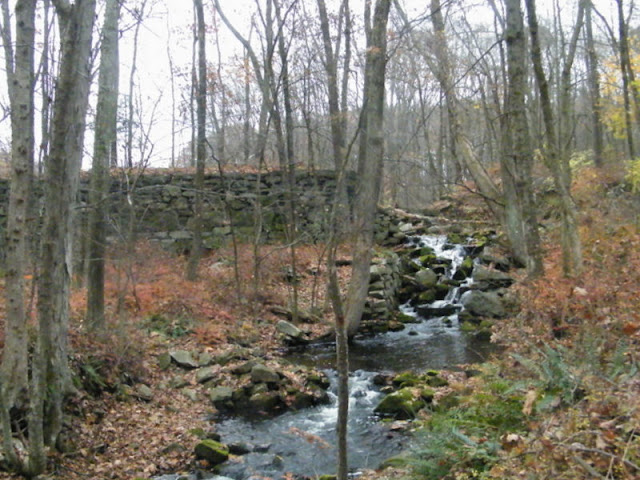The picture above is of the dam itself which was all done by non expert labor which is pretty remarkable when you look at the stone work above. The area would be quiet but looks as if it has potential for many birds including Eastern Screech-owl, Yellow-billed Cuckoo, Louisianna Waterthrush, etc so it will be a nice area to explore when the birds come back next year.
We'd then make our way toward Sutton and stop at a pond on the way which would have some Ring-necked Ducks in it. We'd be watching them when suddenly a goofy duck landed smack dab in the middle with no grace what so ever and that bird would turn out to be a drake Wood Duck. Nervous by us and the clumsy duck, the Ring-necked's would take off leaving the goofy wood all by itself. Alan would remember something he read by Peter Dunne when looking at sparrows which says a flushed group of sparrows will all take off at the same time if they are of the same breed leaving the stray behind so we'd wonder if the same rings true for waterfowl!
After that it would be off to some local powerlines in hopes for an early Fox or American Tree Sparrow. While we'd see neither, birds would be very active with the regulars like Black-capped Chickadees, White-throated and Song Sparrows and one lone Carolina Wren singing up a storm.
And away they go! The picture doesn't do the scene justice considering there were a lot more directly behind these ones. I should note we'd also see a large group of American Crows nearby too which lead me to wonder if these migrating birds can sense the storm further south and are landing for a couple of days to wait it out before heading to their destination?
We'd continue along our way and wouldn't take long to see we'd flushed a flock of birds feeding on the ground and would be happy to see they landed nearby which allowed us a better look. Not only would we see a small group of American Pipits but an even more impressive flock of Horned Larks which was most welcome as it was an FOY. We'd continue along our way in hopes for some Snow Buntings when we'd flush a rather good sized bird from the ground and we'd immediately see it was a shorebird. The bird would do a lazy circle of sorts and I'd be struck at how plain it looked overall which frustrated me as I had no field marks to go by. Luckily enough it would land in the same general area it came from which allowed Alan and I to carefully get closer to the bird without scaring it again. We'd follow the same pattern where we'd walk 4 or so steps and then stop until we were able to see the bird rather well with just the eye and this is what it would turn out to be.
An American Golden Plover!!! This is hands down my favorite picture of them all as it shows that pale plumage under and somewhat behind the eye these plovers sometimes show.
Last one! This would be one of the those birding experiences that's so cool and rare, it will be forever imprinted in my memory. Not only are these birds uncommon, but the views one gets are not always ideal so guessing this will be the closest I'll ever get to one of these extraordinary birds. We'd continue to walk toward it to flush it one more time just to double check making sure there wasn't any black at the wing pits and soon enough it would flee and do a larger circle this time and I'd be happy to see it landed in the same general area again. This would give me instant relief as I didn't want it to leave the area all together and head down the stormy east coast as I'd grown rather attached to the bird so hope it sticks around to wait out the storm (as well as all the others for that matter).
We'd make two more stops in Worcester at All Faith's and Notre Dame cemetery in hopes for some American Wigeon or Northern Pintails and except for three Green-winged Teal and a Pied-billed Grebe the place would be quiet. Don't know what's going on this year but the wigeon are no where to be found.
Take care all.











No comments:
Post a Comment